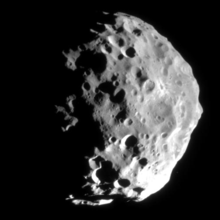Wikijunior:Solar System/Saturn/Phoebe

Phoebe is a moon of Saturn.
How big is Phoebe?
[edit | edit source]Phoebe is about 220 km wide. However, because Phoebe is not very spherical in shape, it is wider in some places and narrower in others.
What is its surface like?
[edit | edit source]
The surface of Phoebe is dark and heavily cratered. Craters are up to 80 km across, one of which has walls 16 kilometres high.
How long is a day on Pheobe?
[edit | edit source]One day on Phoebe is equal to 9 h 16 min 55.2 s on Earth. Unlike the other moons of Saturn, Phoebe does not have synchronous orbit. This means that the time it takes for Phoebe to rotate once is different from the amount of time it takes for Pheobe to orbit once around Saturn.
How long is its orbit around Saturn?
[edit | edit source]One orbit around Saturn is equal to 550.6 days, or 1 and a half years! Phoebe's orbit is retrograde, meaning it moves in the opposite direction of moons such as Rhea or Titan.
What is it made of?
[edit | edit source]
The dark colour of Phoebe led scientists to believe that it was a captured asteroid. However, recent pictures from Cassini show that Phoebe's craters vary greatly in brightnes. This means that underneath the dark surface, there is a large quantity of ice. In addition,quantities of carbon dioxide have been detected on the surface, something which has never been found on an asteroid. It is believed that Phoebe is around 50% rock, unlike the other moons of Saturn, which are about 35% rock. For there reasons, scientists now think that Phoebe is a captured Centaur, an icy planetoid from the Kuiper Belt that orbits the Sun between Jupiter and Neptune.
How much would Phoebe's gravity pull on me?
[edit | edit source]If you stood on Phoebe, you would weigh only 1/25th of what you do on Earth! For example, a 100 lb person on Earth would weigh only 4 lbs on Phoebe.
Who is it named after?
[edit | edit source]Pheobe is named after a Titan in Greek mythology. She was the grandmother of Apollo and Artemis, and mother of Leto and Asteria.
How was it discovered?
[edit | edit source]Phoebe was diacovered by William Henry Pickering on March 17, 1899 from photographic plates that had been taken starting on August 16, 1898, at Arequipa, Peru by DeLisle Stewart. It was the first satellite to be discovered photographically.